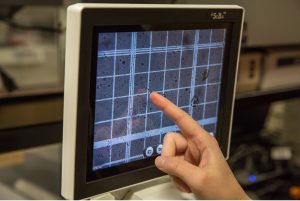Members of the UF/IFAS Honey Bee Research and Extension Laboratory in collaboration with researchers located at Burapha University in Thailand conducted a research project studying the effect of Nosema ceranae infection on the microbiome of honey bees. Below is a summary of the research as well as a link to the full publication.
Background
The microbiome of the honey bee (Apis sp.) is composed of the microorganisms that live along the digestive tract and is important for the overall health of the organism. Lactic acid bacteria (LAB), such as Bifidobacterium sp. and Apilactobacillus kunkeei, are found in the honey bee midgut, and play a significant role in honey production and protection against honey bee pathogens.
Nosema ceranae (N. ceranae) infection, called nosemosis, is an infection caused by the consumption of fungal spores and occurs in the digestive tract. It is spread by both oral to oral and fecal to oral contacts. Colony infection with N. ceranae is associated with a decline in adult honey bee numbers and decreased honey yield. Severe infection can eventually lead to the collapse of a colony.

Purpose
The purpose of this research was to determine how N. ceranae affects the gut microbiome of four studied honey bee species, A. cerana, A. dorsata, A. florea, and A. mellifera. In particular, researchers examined how lactic acid bacteria populations are affected after being infected by N. ceranae.
Key findings
- All four of the honey bee species infected with ceranae showed significantly lower survival rates compared to the uninfected bees (control).
- 5 to 10 days after being infected with ceranae, the spores more than doubled, which showed the rapid spread within the organism.
- Across all four species, the average amount of lactic acid bacteria Bifidobacterium sp. and Apilactobacillus kunkeei in the midgut were significantly lower in ceranae infected organisms vs uninfected.
Significance
This research contributes to the understanding of nosemosis and how it affects honey bee microorganisms. The changes that are seen in the gut microbiome can also contribute to an increase in honey bee pathogen susceptibility after N. ceranae infection. In turn, we can understand how overall honey bee population health, numbers, and yield are correlated to nosemosis.

To read this publication, visit: https://doi.org/10.1080/00218839.2021.1987086
This blog post was written by UF IFAS Honey Bee Lab Fall 2022 intern Katie Gray and revised by Amy Vu and Dr. Cameron Jack.
Naree, S., Ellis, J.D., Benbow, M.E., Suwannapong, G. 2022. Experimental Nosema ceranae infection is associated with microbiome changes in the midguts of four species of Apis (honey bees). Journal of Apicultural Research, 61(3): 435-447. https://doi.org/10.1080/00218839.2021.1987086.
 0
0
